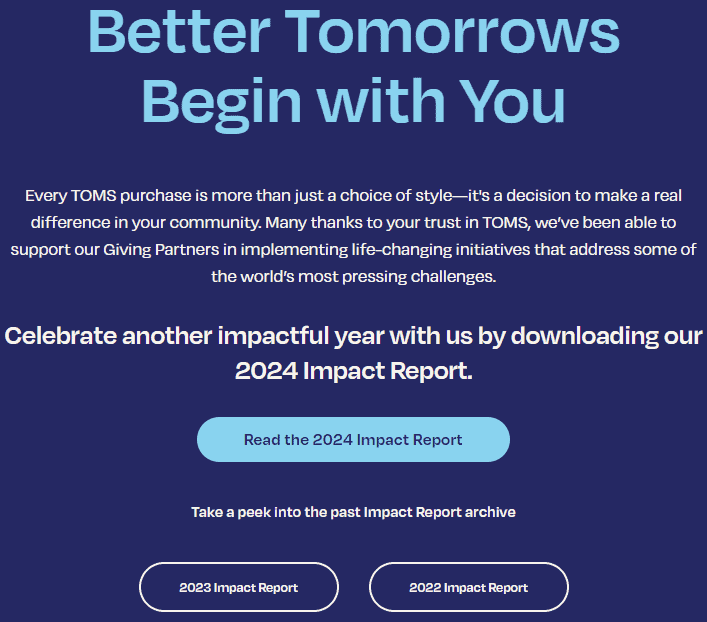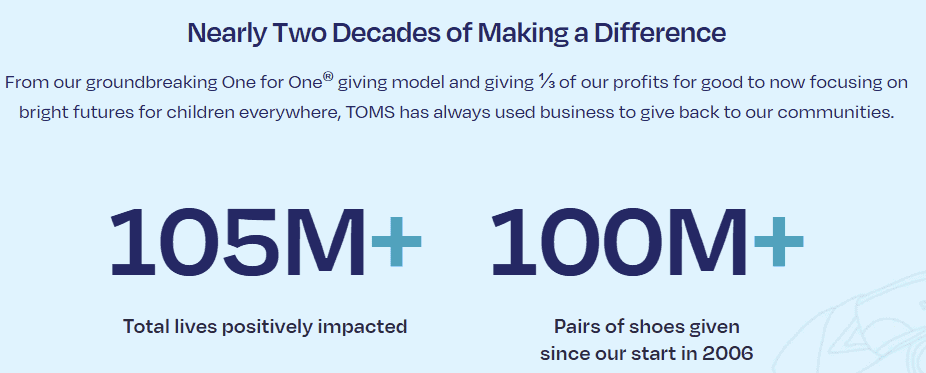Running a business while helping people isn’t just a great marketing plan. It’s the future of shopping. To leave a lasting impression on their customers, brands are doing more than just selling products or services.
They are sponsoring events and activities that help improve the well-being of customers. With every purchase made, brands are making the world a better place by giving back to the people and the environment.
These activities can be making the environment better by cleaning it or visiting less privileged people in the community. These activities help customers see brands as more than just trying to make a profit from them, and that they care about their well-being and want to give a lasting impression that will change their lives. It positively impacts the growth, loyalty, engagement, and trust of your brand with customers and even potential customers.
In this article, we will share ways brands are using social impact marketing to grow an authentic brand, build trust with customers, and generate more leads.
What is social impact marketing?
These are the marketing campaigns that brands use to try to make the lives of their customers and other people better by sponsoring or running events that help improve the environment or the lives of people.
Its importance
- Opens the door to brand growth. Customers and even potential customers will be more attracted to engage and even purchase from brands that sponsor causes that make the lives of people or the environment better.
- Builds customer trust, loyalty, and a deep connection with your brand. Enhances company image, showing that they care more than just solving problems, but also making lives better through causes customers care about.
- Fosters more trust with partners, stakeholders, and employees. People trust brands that give more than solutions to the challenges they face. For example, suppose a brand works on a project to promote environmental welfare on top of solving challenges. In that case, customers will likely purchase from it so they can be part of the brand campaigns to make the environment better.
- Improves customer retention. Customers are proud and feel good about the brand and want to be associated with it, as it does more than solve their challenges. Brands keep making increased profits from their product sales.
- Drives brand awareness. Happy customers will advocate for the brand due to its good causes and the value it delivers in solving problems, putting the brand in front of many potential customers.
- Changes lives for others. When brands advocate social impact marketing, they change the lives of customers and others through charity work. For example, Bombas, a brand that donates a pair of socks to homeless people for every single order made by their customers.
Image source
What Makes Social Impact Marketing Authentic
Alignment with Core Business Values
Internal culture must reflect external messaging. Sponsor an event that aligns with your brand message to build real authenticity and loyalty from customers. It will make it easy for customers to understand your brand and build more trust that can lead to more sales and build even deeper authenticity and trust.
Transparency and Accountability
Clear communication about goals and progress. Let customers know what you’re building and the causes you sponsor. Be transparent from the start and show them that you care about their needs and want to provide more than solutions to their challenges. Be honest about the brands that you partner with to sponsor the event and make the social impact marketing real.
Meaningful Action Over Marketing Speak
Concrete initiatives that create real change. You want to give your customers meaningful things and give them real impact on their lives or the environment for positive change and growth.
Having authentic social impact marketing will involve community and local engagement.
Consistency Across All Touchpoints
Brand voice alignment across channels. You give your customers a visual identity supporting the message, so help them see the value you provide beyond just solving needs for customers.
Through social impact marketing, you give customers an experience reflecting the values your brand shares to build loyalty and trust to keep growing your brand.
Strategies to build an authentic brand with social impact marketing
Cause Selection and Alignment
Choosing causes that genuinely connect to your business. Start projects that align with your business’s core values and missions. Hear what Sharon of Air Ambulance 1 says
We create real brand connection through a genuine commitment to our mission embedded within our marketing by demonstrating real concern for the community through our community stakeholders. The outcome is openness and connection back to your brand and repeated engagement or loyalty, as people become associated with your cause. One example was a program supporting rural access to medical care in underserved populations. We did not just write a check to support the donation; we helped professionally coordinate and deliver emergency response instruction to help local health workers use air medical services more effectively. The qualitative outreach we practiced went so much further than any ad It showed that we care beyond just selling a service and that we are helping make improvements in healthcare at the root cause. The commitment to the community is part of our organizational fabric.
Storytelling That Resonates
Human-centered narratives. Give customer and employee stories that resonate with their daily lives. Things that they can understand. Share behind-the-scenes video content showing real work that your products solve and the impact of the events you’re running for your brand through social impact marketing.
Highlight the cause through user-generated content from your customers. Show the benefits and impacts in real time that the donations have had for the customers and other people. It motivates others to want to donate and be part of that cause for a better life.
Hear what Ben of Electricity Monster says.
One of the most successful things that I coordinated was to get households to lower their electricity bills during a period of rising electricity bills. Instead of the generic push of discounts, I was able to work with local community groups and developed guides that identified how a simple provider switch would save families an average of $240 a year, with real-life examples of customers who were able to save $60 off their quarterly bill without having to reduce their usage. I shared these stories in both written and video content so that people had the opportunity to see how others just like them were benefiting from it.
Partnership and Collaboration
Work with established nonprofits and NGOs, and partner with other brands that can help you run your programmes. You can also encourage and sponsor employee volunteer programs towards the causes you run. Partner with charities or non-profit organizations ( that offer things your customers care about). Search for partners that align with your brand’s core values
Content Marketing Strategies
Have great content that is educational and valuable about the social issues. You can run user-generated content campaigns around your products to help build trust with customers and get them to engage with your programmes cause you run for the betterment of the lives of your customers.
Social Media Engagement
Use different social media sites to get target customers and already customers to have different approaches for different causes you run through your brand and partnership.
You can use hashtag campaigns in your content to get more people to engage with your brand and learn more about your social impact marketing campaigns.
You can also partner with Influencers in your niche to help advocate for your causes. Since these customers trust the influencers, they will more likely engage with the content and build loyalty and authenticity in the industry.
Make it easy for the donation process
If customers want to donate to a good cause, they should do so without any challenges. A complicated process will disrupt your customers and even discourage them from participating.
Be truthful
Show donors where their money goes. Show progress with your good cause and the impact on the people. Building trust through authenticity, openness, and honesty. Here is an example

Source
When customers see real stories or the impact of their donation on the lives they’re changing, they will be more open to continuing to run those campaigns by making more purchases to sponsor those causes.
Measuring Success and ROI
As you run your social impact marketing campaigns, you can test metrics to see the progress and advancement of your brand marketing. Here are some of the metrics you can measure.
Traditional Marketing Metrics
Brand awareness and sentiment tracking. You can track how the campaigns are increasing awareness of your brand and building trust with the target audience. Evaluate how the target audience is engaging with your brand and how effective these campaigns are in reaching more customers and helping with customer acquisition and retention for past customers.
Impact-Specific Metrics
See how actual social/environmental outcomes are achieved with your campaigns. For instance, if the cause is planting trees, then showing people trees that are actually growing motivates and drives them to sponsor more planting to better the environment. Here is an example

Source:
You can also factor in and evaluate the community engagement levels with your campaigns and how they are reacting to it. See your employee satisfaction and retention improvements as you run the social impact marketing campaigns.
Long-term Business Benefits
A great social impact marketing strategy helps with brand equity building. Building authenticity gives brands a competitive advantage in a crowded market.
Common Pitfalls to Avoid
- Jumping on trending causes without a genuine connection
- Over-promising and under-delivering on impact
- Ignoring internal culture while promoting external values
- Treating social impact as a marketing campaign rather than a business philosophy
Future Trends and Considerations
- Emerging social issues brands should consider
- Technology’s role in impact measurement and transparency
- Regulatory changes affecting corporate social responsibility
- The evolution of consumer expectations
Final Thoughts on Social Impact Marketing
Showing your customers value you can provide value beyond solving their challenges and using part of their contributions to better humanity and improve the value of other people’s lives is a great initiative for any brand.
More brands are starting social impact campaigns that build more trust with leads and customers. If you’re planning on running social impact campaigns, try these strategies to build an authentic brand connection.









